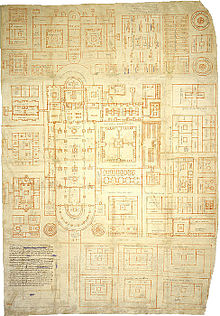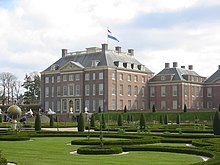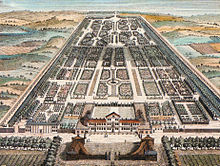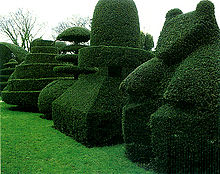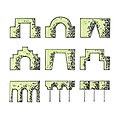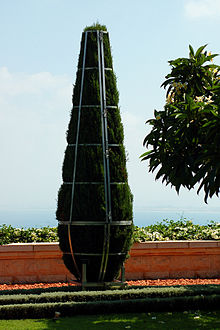Topiary
Under topiary is meant to bring plants by special cutting techniques in a mostly geometric shape and to give them an architectural, ornamental or figurative appearance the art.
term
Occasionally, the term topiary is used in German . It is related to the English topiary , whereby only shape trees are understood to exclude broderie . Topiary comes indirectly from the Greek word τόπος tópos "place, landscape": The Latin names topiarius for "art gardener" and ars topiaria for "garden art" were derived from this. The latter expression was used from the Renaissance onwards for the artistic pruning of plants. In French , topiary is called art topiaire .
history
Antiquity
The art of topiary has a tradition that goes back thousands of years. Egyptian tomb paintings, Persian miniatures and Roman frescoes show shaped plants. We know of garden slaves of Greek origin, the topiarii, who worked for emperors and wealthy families in the Roman Empire. Pliny the Elder owned vineyards that he had edged with cypress trees . In his work Naturalis historia from the year 70 AD he remarked: “... but nowadays they are trimmed in order to give them a slim shape. Some are also artistically cut into hunting scenes, ships' fleets and replicas of other objects. ” His nephew Pliny the Younger described in the garden of his Villa Laurentium “ a terrace surrounded by a hedge made of box that is decorated with various shapes. From there a slope leads downhill, lined with opposite pairs of animals made of cut box. "
middle Ages
When the Roman Empire collapsed in the 5th century, low hedges were drawn around the vegetable and herb beds, especially in monastery gardens . An example of this is the St. Gallen monastery plan from the early 9th century. A special form of pruning were dance and court linden trees . Strong branches were laid flat over large wooden hoops, so that a walk-on area was created that was covered with planks. Tanzlinden are still z. B. in Peesten , Grettstadt or Sachsenbrunn .
Renaissance
Topiary was revived in the Renaissance. The architects of castles and country estates created formal gardens with terraces and mazes . In the strictly geometrical scheme, the cut trees served as structural elements. French was spoken in the courtyards and the gardeners also used this language. They created ornate beds, called parterres , surrounded by low hedges . Inside the borders grew the culinary herbs in the potager , the medicinal plants in the médicinal and colorful flowers in the bouquetier . The French writer Olivier de Serres (1539–1619) compared the design of a parterre with the work of a painter. The flower beds should look like a painting in a precious frame. This frame consisted mainly of boxwood, but also of lavender, wormwood, holy herb and hyssop.
Parterres with curved and intertwined patterns symbolize forms of love, such as in the garden of love in the park of Villandry Castle (France), where box hedges are made into hearts, butterflies, flames, masks, fans or swords. The model for the vegetable garden there were engravings by Jacques I. Androuet du Cerceau from 1576.
Many topiary gardens in England date from this period. During the reign of Henry VII , knot gardens were created around 1500 from cut boxwood or lavender. Henry VIII's garden at Hampton Court Palace was decorated with figures such as running greyhounds, deer, bears, urns and boats. Sir George Sitwell wrote in On the Making of Gardens in 1909: “Even the topiary figures of the Renaissance, the green ships and helmets, giants, dragons and centaurs, made sense. Because they were so unusual, they attracted attention, stimulated the imagination and strengthened the memory. "
Famous gardens in Italy are for example the gardens of the Villa Medici (Poggio a Caiano) , the Villa d'Este , the Villa Lante , the Villa La Petraia or the Giardino Giusti near Verona . The architect Leon Battista Alberti designed the Villa Quaracchi near Florence for Giovanni Ruccellai in 1459 . In his diary he noted Alberti's designs for topiary figures, namely balls, columns, temples, vases, urns, monkeys, donkeys, oxen, a bear, giants, men and women, warriors, a witch, philosophers, popes and cardinals.
Around 1613 the Hortus Eystettensis was created in Eichstätt . Basilius Besler wrote the book of the same name on 1084 plants with 367 copperplate engravings, after which the bastion garden was redesigned in 1998 with thematically planted beds.

From 1614 to 1619 the first German Renaissance garden, the Hortus Palatinus, was created in Heidelberg Castle Garden . Salomon de Caus designed it for Friedrich V with four knot beds made of differently high and therefore three-dimensional plant bands, which mostly contained different types of wood and shrubbery in several shades of color.
In 1632, in his horticultural textbook Horticultura , Peter Lauremberg recommended privet, rosemary, bladder bush, hawthorn, juniper, barberry, laurel and lilac for topiary and gave detailed instructions for the design of hedges. Scaffolding for all sorts of figures made of debarked hazelnut rods was accordingly made in the winter months and planted in spring.
Baroque
From the beginning of the 17th century, the court architects developed the baroque park as part of the overall concept of a palace. The new garden style soon spread across Europe. The garden of Versailles became the model for many gardens . The court gardener of Louis XIV , André Le Nôtre , perfected the geometry in it. “In his garden style, which is determined by 'happy mathematics', the plants with their peculiarities and effects are subordinate to the architecture and ornamentation of the garden. Hornbeam and boxwood are - alongside stone, wood and water - the living materials with whose help lines and squares, arabesques and palmettes , perspective and harmony are created. ” The strict forms corresponded to the absolutist government of the French kings. Man forced nature into an order he had created, thereby increasing the effect of the magnificent architecture of a castle. The kitchen garden was outsourced, pleasure gardens were created. The surrounds became entwined arabesques and volutes between gravel or sand in contrasting colors. They were called broderies because they looked like delicate embroidery. In the case of yew trees, which were cut in layers in layers, up to seven plate-shaped rows of branches stood on top of each other at the same distance.
Not all contemporaries were enthusiastic about this garden style. In 1625, Francis Bacon described such tree figures as childish in his Essay on Gardens . Even Louis de Rouvroy , assessed the garden of Versailles skeptical: "The gardens are certainly wonderful, but unpleasant to use, and they are evidence of bad taste. You can't reach the cool shade without walking through dry heat ... The stone pavement of the paths burns your feet, but if it weren't there you would sink into the sand or black mud. The violence inflicted on nature is repulsive. ” The gardens of Vaux-le-Vicomte , Maincy , Ile-de-France and Het Loo in Belgium are also famous.
The Great Garden in Hanover-Herrenhausen , which was laid out in 1666 as a summer residence for Sophie, wife of Prince Ernst August , is the only baroque garden in Germany that has been preserved in its original size and shape. On the 31,000 square meter baroque ground floor there are splendid and richly designed box broderies with pieces of lawn, ribbons of gravel and flowers. The monarch imitated French garden art and luxurious court rulings based on the model of Louis XIV. His master horticulturalist Martin Charbonnier was a student of André Le Nôtre as well as Dominique Girard , who designed the gardens of Augustusburg Palace in Brühl , Nymphenburg Palace in Munich , Schleissheim Palace and Belvedere Palace designed in Vienna. From 1744 to 1764 the rococo pleasure garden Sanssouci was built for Frederick the Great with a terraced vineyard, marble colonnades and a Chinese tea house. Other well-known baroque gardens in Germany are in Großsedlitz near Dresden , Würzburg , Bayreuth and Schwetzingen .
romance
In the 18th century, the strictly circled garden went out of fashion and with it the topiary. The English landscape garden with naturally grown trees and shrubs was preferred. Garden architects redesigned formerly baroque gardens and parks. “In the romantic era, the design of plants reached a low point. Many formal gardens have been destroyed or overgrown according to the romantic ideas of their owners. In England they warned that if this method were quickly changed, there would soon no longer be three trees in a row. "
19th century
In the 19th century, formal gardening ideas returned and mixed with other style elements. New shapes such as spirals emerged, and plant species such as rhododendrons or ilex were used to cut shapes . Industrialists who had become prosperous had representative country houses built with large gardens, especially in England.
The Earl of Barrington had a large Victorian garden built between 1840 and 1850 in Elvaston Castle , Derbyshire , with a ten-meter high hedge made of old yew trees, giant topiary birds and other figures. Some of them were already shaped in the Elvaston Nurseries tree nursery before they were brought into the palace gardens. John Loudon reported, “Many large plants… had to be brought through Derby town on their journey . Some were so huge that the windows to the right and left of the street broke. ” This garden became the model for other English gardens. The English nobility had large and elaborate gardens laid out, the costs of maintenance and care were then insignificant. The Countess of Westminster was therefore able to employ 85 gardeners, 55 outdoors and 30 in the greenhouses.
In Portugal, camellias were often used for topiary. The Chinese plant was imported from England between 1800 and 1810 and thrived in the warm and humid climate of northern Portugal. The plants are often taller than a man and are either cut into geometric shapes such as cylinders, obelisks or pyramids or form arbors over a wooden framework ( casa do fresco ). The plants bloom between January and March and are pruned from June. Good examples can be found in the gardens of Casa do Campo, Douro , Casa des Condes de Campo Belo in Vila Nova de Gaia , Quinta do Alao, Porto and Casa dos Biscainhos in Braga .
20th century
In the 20th century, formally designed gardens met the linear architecture and adapted to it. Well-known garden designers such as Edwin Lutyens , Gertrude Jekyll and Reginald Blomfield defended the art of topiary; the latter in particular rejected near-natural plantings and called for a return to the topiary art of the Middle Ages. Above all, companies, hotels, banks and stately agencies had gardens that were designed in a strict and, precisely for that reason, very modern style with comparatively little financial expenditure. However, they are not undisputed. “The 20th century is characterized by an ideological dispute between proponents and opponents of formal gardens and designed plants ... Topiary trees in the garden are always cause for admiration, but sometimes also for discussion. People often speak of raped nature. "
An exceptional example is the cemetery in Tulcán , Ecuador , 150 kilometers north of the capital Quito, redesigned in 1936 by José Franco Guerrero . It has a regular rectangular pattern of hedges and passages. Arcades are crowned geometrically or figuratively, there are obelisks , caryatids and various animals. South American heroes, Incas and Aztecs were also designed. Huge trees make up an elephant or an astronaut. Artful reliefs have been cut into the cypress hedges.
In the park of the School for the Deaf in Columbus , Ohio , USA , the sculptor James Mason recreated Georges Seurat's painting Sunday on the island of Grande Jatte on 2000 square meters with topiary trees. There are 50 figures on black lacquered iron frames, the largest figure being 3.5 meters high, there are also eight boats, three dogs, a monkey and a cat. Hundreds of unusually shaped trees grow in Pearl Fryar's Topiary Garden in Bishopville , South Carolina , USA. Another example from the US is the manicured garden at the Getty Museum in California .
A modern box garden was created at the Hilton Munich Airport in 1994, designed by the American landscape architect Peter Walker . Six meter high hornbeam pyramids stand between yew cubes, there are lavender parterres and areas of colored gravel. In the Sony Center in Berlin, another garden, this architect was built in the 2000th Under a rotating canopy made of steel and glass, two areas of boxwood grow with 33,000 plants from which poplars, birches and linden trees protrude. Other well-known garden designers who work with topiary are Jacques Wirtz (Belgium) and Piet Oudolf (Netherlands).
Towards the end of the 20th and the beginning of the 21st century, Topiari began a triumphant advance through public and private gardens. In 1996 Topiarius magazine was founded in England . In cottage gardens, the idea of the monastery gardens is taken up to enclose the beds with box hedges in a rectangular or square arrangement. Often there is also a crossroads in the middle of the garden, which is sometimes extended to a roundel with a conspicuous solitary plant, a little fountain or a statue.
Public open spaces are planted with coton or creeper ; Bushes, yews and bamboos can be arranged in a contemporary way and combined with naturally grown plants. Box balls are now found in many gardens on the lawn, in borders and in the center of herb gardens. Nurseries and garden centers offer a large selection of ready-cut plants.
The increasing spread of the tubular fungus Cylindrocladium buxicola , which leads to the death of the infested box trees, is placing increasing limits on the spread of this type of use. The fungus appears to spread particularly through leaf blowers in gardens and parks.
East asia
The Far Eastern garden art differs considerably from the European one.
Chinese gardeners strive to unite earth, sky, stones, water, buildings, paths and plants in harmony. Bonsai and aesthetically shaped trees such as pines or maples stand in front of a white wall or lean over a surface of water. The garden is a scaled-down, idealized landscape and is understood as an abstract work of art. Constant pruning of roots, shoots and leaves limits growth; unique and individual plant shapes are created. The growth form of young plants is, for. B. by wiring , shaped so that they get the appearance of an aged tree. There are strict rules for topiary and the placement of each plant.
Descriptions of it reached around 1600 through the first travelers to the Far East and the East Indian companies to Europe. The Franciscan Mattes Ripa brought copper engravings with him from his trip to China that delighted the English nobility and subsequently produced a hybrid of a geometric and natural garden, namely the Jardin chinois-anglais .
In the rococo pleasure garden of Frederick the Great's Sanssouci , like in many other parks of the time, a Chinese tea house was built. In the 20th century, also due to the new interest in Far Eastern philosophies, many Chinese gardens emerged, for example in Munich , Frankfurt , Zurich and Vancouver .
practice
use
Topiary plants are mostly used sparingly due to their dominant effect. Exceptions are marked topiary gardens or bonsai collections. Few, but robust and proven species are adapted to the garden size and style. Depending on the cut, they bring calm or movement into the garden area. Spheres or cuboids appear static, spirals, curved hedges or paths appear dynamic. Vaulted wooded areas and design elements that are repeated create a rhythm and tension. Color contrasts arise, for example, when dark and light foliage is combined, light plants stand in front of a dark green yew background or snow traces and emphasizes the cut shapes. The combination of plants of different sizes in groups results in contrasts in size , as well as when a solitary plant rises above an area of low ground cover. The gardener creates form contrasts by putting together round and angular, wide and narrow, pointed and blunt plant shapes.
Trimmed hedges separate garden spaces, serve as privacy and sound protection, form a demarcation from neighboring gardens and are often used as a background for colorful flower borders. Spatial axes direct the view in certain directions, paths are accompanied by juniper avenues or rows of beech balls, as in Blandy's Garden on Madeira . All solitary plants are particularly striking; Eye-catchers such as large animal figures are, for example, in the Green Animals Topiary Gardens in Portsmouth , Rhode Island , USA, in King Rama IX Park in Bangkok and in Mumbai , India in the Ferozeshah Mehta Gardens , where there are hanging gardens with life-size giraffes, Elephants and monkeys are located.
Plant selection
Decisive for the choice of the plants to be formed are growth form, vigor, foliage, flowers and fruit decorations, but also soil requirements, location requirements, frost hardness, resistance to pests and diseases as well as cut tolerance must be considered. The popular boxwood as is increasingly affected by dieback, boxwood cancer and the carrying wilt, and there is some years defoliation by the cydalima perspectalis .
Classic hedge plants are hardy deciduous or coniferous trees such as yew , thuja , false cypress , boxwood , hornbeam , privet , firthorn and barberry . Hawthorn , field maple , holly and juniper are particularly effective as solitaires. Forsythias , rhododendrons and azaleas are an extraordinary ornament cut into balls.
In palace gardens you can occasionally find tree walls made of winter linden , red beech , hornbeam, medlar or plane trees . They have crowns trimmed into spheres or blocks or, with their evenly spaced trunks and branches tied to wires, form long avenues.
Pears, apples, peaches and grapes are preferably grown on trellises . As phylum may include Wisteria pear, Willowleaf Ginkgo , willow, olive or bay be formed. But shrub marguerite , fuchsia and convertible florets are also popular as patio decorations. Boxwood, cotoneaster or spindle bush are suitable for wooded areas , as are yew, Japanese holly or diamond azalea. This alternative to lawn requires little maintenance and there are no problems with weeds.

Mediterranean subshrubs such as real lavender , rosemary , noble germander and gray saintly herb are often used for edging in the vegetable garden, as gray foliage, flower color and fragrance provide variety. Bonsai is mainly made from pine, Japanese holly, privet or Japanese maple . Large bonsai can reach a considerable height and are primarily used as eye-catchers in Chinese or Japanese- inspired gardens. Most of the listed plants are suitable for planters , but also ivy , which covers and fills wire frames and trellises in a short time.
cut
Plants generally grow upwards, with the topmost shoot tip being preferred ( apical dominance ). If you cut away the central shoot, so-called sleeping eyes and lateral buds are stimulated by hormonal stimuli and sprout. By removing these shoots, the desired bushy growth with a dense surface is created.
The first cut is the design cut . Here you first define the rough shape. In the maintenance cut , an increasingly dense branching is aimed for. The final size of the plant can be precisely determined by shortening it more or less. Older plants are stimulated to sprout into the old wood through a rejuvenation cut, usually carried out in stages (see also under capping (tree) ). They are then protected with shade cords and thus prevent damage from drying out. The topiary is usually done in June. Young and vigorous plants are often cut twice, in March and at the end of June, complex figures are also more often.
Tools and aids
Manual cutters are hedge shears , secateurs, sheep shears, pruning shears or tree saws . Lawn edging shears and hedge trimmers in various sizes are also available electrically operated or as a cordless device. A plumb line, ruler and plumb bob are essential for cutting straight shapes. For large plants you need ladders or work platforms. Some gardeners use semicircular templates to cut precise spheres. The boxwood parterre in the monastery of San Lorenzo de Trassonto in Santiago de Compostela from the middle of the 17th century is so densely grown that it can only be cut from above with the help of a scaffold.
The plants can also be trained to their final shape on a metal trellis , a climbing aid made of wood, bamboo or willow and with the help of a wire frame. With large bonsai , the branches are brought into the desired position using sticks, cords and fastening straps.
literature
sorted alphabetically by author
- Helena Attlee: The gardens of Portugal . Frances Lincoln, London 2007
- Heinrich Beltz: Topiary: cultivation and care . Blackwell Wissenschafts-Verlag, Berlin 1999. ISBN 3-8263-3220-2
- Heinrich Beltz: Cutting topiary trees . Eugen Ulmer Verlag, Stuttgart 2007. ISBN 978-3-8001-5429-6
- Rolf Blancke: works of art in green. Raising and caring for topiary trees . 2nd Edition. Eugen Ulmer Verlag, Stuttgart 1997. ISBN 3-8001-6629-1
- Gordon Gaylor and Guy Cooper: Garden Art. Green obsessions . Verlag Busse and Seewald, Herford 2000. ISBN 3-512-03212-5
- Christa Hasselhorst : In good shape. The old art of topiary is becoming increasingly popular with amateur and professional gardeners, in: FAS No. 2, January 14, 2018, p. 59.
- Thomas Scheliga: ARS TOPIARIA of the Renaissance and Manirism in Europe's princely gardens. A contribution to the anniversary "400 years of pleasure garden in Hessen am Fallstein" . In: Die Gartenkunst 23 (1/2011), pp. 55–70.
- Gerda Tornieporth: Box in the garden . BLV Verlagsgesellschaft, Munich 2001. ISBN 3-405-16058-8
- Gerda Tornieporth: The big book of the book . BLV Buchverlag, Munich 2005. ISBN 3-405-16808-2
- Dorothée Waechter: Topiary, step by step . BLV Buchverlag, Munich 2011. ISBN 3-405-16840-6
- Clemens Alexander Wimmer : Ars Topiaria: The story of the cut tree . In: Die Gartenkunst 1 (1/1989), pp. 20–32.
Web links
- European Boxwood and Topiary Society (English)
- Boxwood Garden, Stately hedges, Edges & Topiary (English)
- Topiary Arts (English)
- Drummond Gardens, Scotland (English)
Individual evidence
- ↑ a b c d Gaylor / Cooper, p. 12
- ↑ Gerda Torniepoth: Book in the garden . BLV Verlagsgesellschaft, Munich 2001, p. 13
- ↑ Gaylor / Cooper, p. 10.
- ↑ Bastion garden with plants from the Hortus Eystettensis. Information portal of the city of Eichstätt.
- ↑ Gerda Torniepoth: The big book from the book . BLV Buchverlag, Munich 2005, p. 11
- ↑ Dorothée Waechter: topiary .BLV Verlag, Munich 2005, p 10
- ↑ a b Gaylor / Cooper, p. 172
- ↑ Blancke, p. 15
- ↑ Attlee, p. 23.
- ↑ Attlee, p. 65.
- ↑ Attlee, p. 26.
- ↑ Attlee, p. 33.
- ↑ Attlee, p. 45.
- ↑ Blancke, p. 17.


